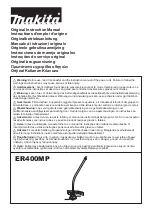
SCOPE displays are defaulted in “Glitch Detection” mode. This means that all signals are sampled at the full sample
rat e of the inst rument and the minimum and maximum excursions are always shown on the display, even if the
horizontal time setting is too slow to show each individual sample interval. In this mode, every noise spike of 40 ns
and wider will be displayed.
INPUT A Control Functions
When you are in SCOPE, you can control the INPUT A functions as follows:
DC Coupling allows you to measure and display both the DC and AC components of a signal. AC Coupling blocks
the DC component and passes the AC component only. GND grounds the input of the instrument internally.
INPUT B Control Functions
When you are in SCOPE, you can control the INPUT B functions as follows:
When you entered SINGLE DISPLAY, INPUT B is turned off by default, but you can turn it on by pressing F2.
5-3
Function keys and Result Screen
Automatic ranging and signal tracking is on.
Pressing AUTO ( ) sets automatic ranging and signal tracking on and off.
If on, AUTO is displayed, if off, AUTO is disappeared.
Trigger level voltage of INPUT A.
Time base range.
Trigger icon. Indicates trigger slope ( indicated negative slope).
Auto triggered.
INPUT A range setting.
INPUT B range setting.
Indicates signal source channel A.
INPUT A zero level.
Indicates trigger location.
Indicates signal source channel B.
INPUT B zero level.
Making an Easy Setup
When you enter the scope mode, the instrument automatically optimizes vertical range, time base, and t rigger
settings to create a stable display. (Autoranging is default)
• When you press one of the Voltage and Time control keys, the instrument switches to manual control of range
and trigger settings.
• Press AUTO ( ) to toggle between automatic and manual control of range and trigger settings. Use this key if
you cannot get a stable display using manual control.
5-2
Figure 12. Scope Display
SCOPE
INPUT INPUT SINGLE KEYS
TRIGGER
A B SHOT
MOVE A
Press t o re turn to th e
previous menu.
Press to select DC, AC or GROUND coupling.
Press to invert the INPUT A
signal waveform.
Press to turn INPUT B on or off.
Press to select DC, AC, or GROUND coupling.
Press to invert the INPUT B
signal waveform.
SCOPE
INPUT INPUT SINGLE KEYS
TRIGGER
A B SHOT
MOVE A
SCOPE INPUT A
COUPLING
INVERT KEYS
BACK
D C
OFF
MOVE A
SCOPE INPUT B
DISPLAY COUPLING INVERT KEYS
BACK
OFF
D C
OFF
MOVE B
















































